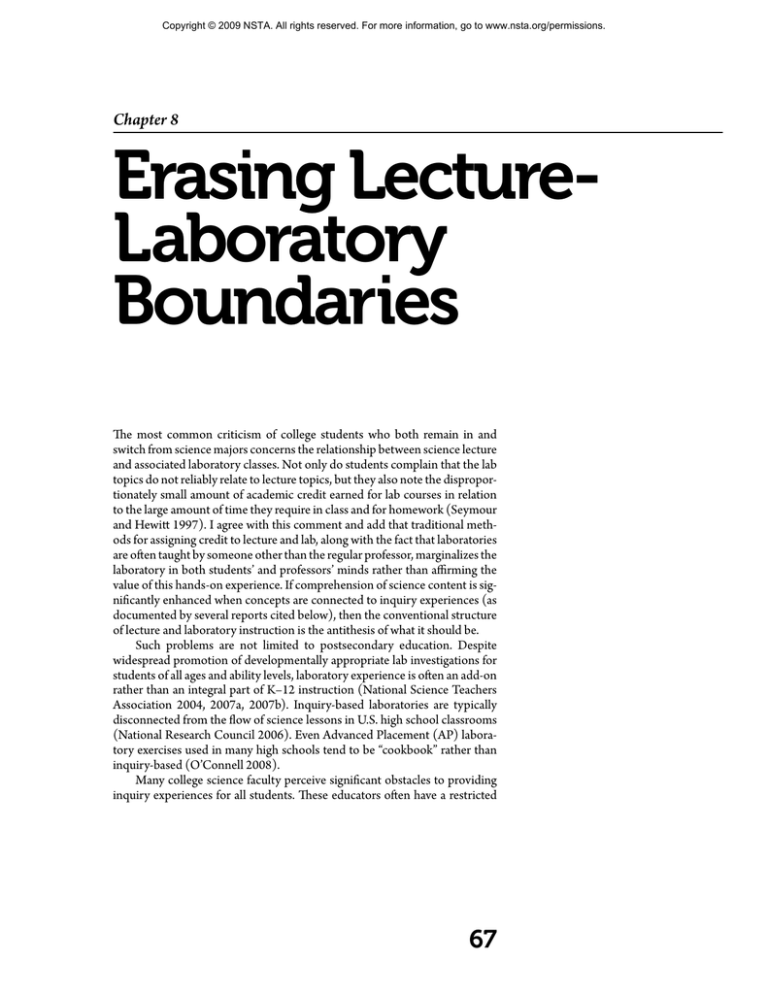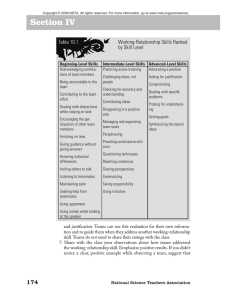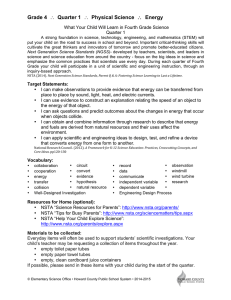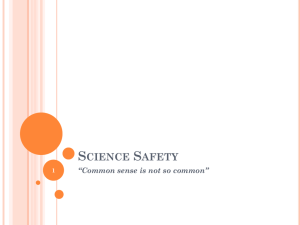
Copyright © 2009 NSTA. All rights reserved. For more information, go to www.nsta.org/permissions.
Chapter 8
Erasing LectureLaboratory
Boundaries
The most common criticism of college students who both remain in and
switch from science majors concerns the relationship between science lecture
and associated laboratory classes. Not only do students complain that the lab
topics do not reliably relate to lecture topics, but they also note the disproportionately small amount of academic credit earned for lab courses in relation
to the large amount of time they require in class and for homework (Seymour
and Hewitt 1997). I agree with this comment and add that traditional methods for assigning credit to lecture and lab, along with the fact that laboratories
are often taught by someone other than the regular professor, marginalizes the
laboratory in both students’ and professors’ minds rather than affirming the
value of this hands-on experience. If comprehension of science content is significantly enhanced when concepts are connected to inquiry experiences (as
documented by several reports cited below), then the conventional structure
of lecture and laboratory instruction is the antithesis of what it should be.
Such problems are not limited to postsecondary education. Despite
widespread promotion of developmentally appropriate lab investigations for
students of all ages and ability levels, laboratory experience is often an add-on
rather than an integral part of K–12 instruction (National Science Teachers
Association 2004, 2007a, 2007b). Inquiry-based laboratories are typically
disconnected from the flow of science lessons in U.S. high school classrooms
(National Research Council 2006). Even Advanced Placement (AP) laboratory exercises used in many high schools tend to be “cookbook” rather than
inquiry-based (O’Connell 2008).
Many college science faculty perceive significant obstacles to providing
inquiry experiences for all students. These educators often have a restricted
67
Copyright © 2009 NSTA. All rights reserved. For more information, go to www.nsta.org/permissions.
Chapter 8: Erasing Lecture-Laboratory Boundaries
conception of inquiry and limited knowledge of how to incorporate it into the
undergraduate science curriculum. They narrowly define scientific inquiry to
be participation in independent laboratory research, and most schools do
not have the resources to offer such experiences to every science student. An
effective substitute is modification of lab exercises and other classroom activities to require students to use the kind of thinking that characterizes research
as they develop a deeper understanding of science and scientific inquiry.
Although cookbook-style laboratories can develop some aspects of
scien­tific reasoning and may boost interest in science, they have little effect
on helping students truly understand concepts. Recent studies demonstrate
that inquiry-based, hands-on laboratory teaching increases comprehension
of complex biological concepts compared to the standard or “cookbook”
formats (Rissing and Cogan 2009). Standard laboratory exercises often are
limited in scope and focused on mechanical procedures rather than meaning.
As described by the Boyer Commission on Educating Undergraduates in the
Research University (1998), the difference between cookbook and inquirybased labs is authenticity. The commission’s analogy is the difference between
watching a live sporting event and seeing something replayed on TV where
the final outcome is already known. If we want students to learn to play the
game of research, we have to let them onto the field. Whether a laboratory
experience is in fact superior to listening to a lecture or watching a demonstration by the teacher depends on the extent to which understanding of concepts
and problem-solving procedures is emphasized (McKeachie 1999).
If cooperative learning groups (Chapter 12) complete inquiry-based lab
exercises and other assignments within the context of a course, then students
interact with their team members, their instructor, and other learning teams.
All these activities contribute to a collegial spirit among participants, model
the scientific process, and stimulate excitement about science. The results
of the work of Udovic et al. (2002) provide evidence that inquiry-oriented
activities help students construct a better understanding of fundamental scientific concepts and improve their ability to use the information to solve unfamiliar problems. Other studies report that in disciplines such as physics, teaching problem solutions by going through a routine series of steps during class is
not an effective way to develop students’ understanding (McKeachie 1999).
With practice an educator can incorporate inquiry into any situation in
which questions are posed and students attempt to solve problems in groups
during class. Buck, Bretz, and Towns (2008) developed a rubric to quantify
the level of inquiry for a particular exercise. They describe six characteristics
to evaluate the degree of student independence and then define five levels that
indicate the extent to which a lab investigation provides directed guidance to
students in terms of the six characteristics. Each level denotes a specific form
of inquiry. Their rubric is useful for assessing one’s current laboratory exercises and also for modifying them to be increasingly inquiry-based.
During my decade of science teaching reform, I gradually erased lecturelaboratory boundaries by weaving all elements together into an inquiry-based
course design (Wood 2009a, 2009b). This style of instruction is not only
68
National Science Teachers Association
Copyright © 2009 NSTA. All rights reserved. For more information, go to www.nsta.org/permissions.
Chapter 8: Erasing Lecture-Laboratory Boundaries
more engaging for students but also models how real science is done. Others
have evaluated similarly integrated science courses for education majors
(Edgcomb et al. 2008) and zoology and botany courses at a large research
university (Burrowes and Nazario 2008). Their data demonstrate increased
academic achievement, conceptual understanding of science content, and
ability to apply scientific process skills. When full integration of lecture and
lab is impractical, other methods can effectively incorporate inquiry into large
lecture courses (Herreid 2007; Pukkila 2004).
I believe that if preservice teachers experience rigorous, inquiry-based
activities within their regular college science courses (not just in their science
teaching methods classes), they will naturally use this pedagogy once they are
responsible for their own classrooms. Requiring college students to design
and conduct their own experiments develops laboratory skills that prepare
future teachers to effectively and safely lead lab exercises. Edgcomb et al.
(2008) report an increase in students’ confidence in their ability to teach science after completing their integrated lecture-laboratory courses.
When liberated from a step-by-step list of laboratory exercise instructions,
I observe my own students growing increasingly comfortable in the lab setting.
Although I closely supervise them, students take control of their own experiments: They choose and find appropriate supplies on the laboratory shelves and,
when the exercise is complete, carefully wash and put away glassware and equipment. If undergraduate science instructors consistently model inquiry-based
labs, future K–16 science educators will more easily employ these methods.
Beyond benefiting students who will become educators or researchers
after graduation, “scientific literacy is best served when students are engaged
in inquiry” (National Research Council 1996). Scientific inquiry is a powerful
way to improve understanding of science content. Students learn how to make
observations, ask questions, state hypotheses, design and conduct investigations, collect evidence from several sources, examine data and develop explanations for the data, and communicate or defend conclusions about whether
or not the original hypothesis is supported. Increasing numbers of science
educators observe that participating in real scientific investigations enhances
students’ attitudes toward science, their motivation for learning, and their conceptual development in the discipline. I strongly recommend incorporating
this peda­gogy into all science instruction, particularly introductory courses.
If hands-on laboratory exercises are impossible, virtual problem-solving environments can provide an analogous experience (DeHaan 2005).
As I describe in Chapter 1, my original goal for reforming my teaching methods was simply to lead some sort of active learning exercise during
every class meeting. I began by adapting ideas of others and later designed
some activities of my own. But with the inclusion of in-class activities, my
students and I felt rushed, and the topics lacked coherence when activities
ended abruptly without adequate closure or had to be completed at home or
during the next class meeting. In response I changed “lecture” sessions from
50 minutes three times per week to 75 minutes twice a week.
Lecture-Free Teaching
69
Copyright © 2009 NSTA. All rights reserved. For more information, go to www.nsta.org/permissions.
Chapter 8: Erasing Lecture-Laboratory Boundaries
Ultimately, I erased the arbitrary boundary between lecture and laboratory. In contrast to the customary weekly schedule of three 50-minute lectures
plus a three-hour laboratory at a different time of the week, sometimes with
an instructor other than me, my classes now meet with me alone in the laboratory twice a week for two approximately three-hour sessions. I am gradually
replacing instructor demonstrations and cookbook-style laboratory exercises
with inquiry-based activities. In their cooperative learning teams (Chapter
12), students apply the scientific process to develop hypotheses and then
design and perform experiments. My formative and summative assessments
complement and reinforce the inquiry-based approaches.
An Inquiry-Based Course
Design
For General Biology I, the semester’s first activity provides a foundation for the
inquiry-based laboratory exercises in which students will participate during the
next 15 weeks. The initial class meeting is an ideal time to introduce the use
of case studies (Chapter 15), with students working in their newly organized
cooperative learning teams (Chapter 10). An introductory case about possible
health risks attributed to cell phone use (as discussed in Chapter 3) is inherently
interesting to students and acquaints them with the scientific process and the
structure of their future scientific reports of laboratory investigations, shown
in Appendix B-7. I intentionally avoid the term lab report to differentiate what
I expect for this writing assignment from what they may have produced as high
school students after completing a cookbook-style laboratory exercise.
During Week 2 of the semester, learning team members examine the
General Biology I Topic Schedule (Appendix A-1) for dates of the four or five
lab exercises I identified as inquiry-based. Each student on a team chooses a
different exercise for which he or she will write the scientific report. During a
recent semester, students investigated diffusion and osmosis, enzyme activity,
photosynthesis versus cellular respiration in plants, fermentation in yeast, and
eutrophication. Before the date scheduled for each exercise, I expect students
to have completed the assigned textbook reading. Guided by my written and
verbal instructions, they first practice relevant laboratory procedures. Then
each team chooses from a selection of subtopics to investigate. They decide
on and state a hypothesis, after which they design and perform an experiment
to test the hypothesis. The experiment must be one that can be accomplished
during the time allotted using supplies and equipment available in the laboratory or on campus. In the case of the eutrophication lab (Appendix C-3), we
traveled to nearby ponds and lakes to collect water samples. Although students complete each investigation as a team and all team members are responsible for participating in laboratory procedures and understanding related
concepts, only one student from each team writes the scientific report for a
specific investigation, and he or she is graded individually on this report, as
described in Chapter 11.
70
National Science Teachers Association
Copyright © 2009 NSTA. All rights reserved. For more information, go to www.nsta.org/permissions.
Chapter 8: Erasing Lecture-Laboratory Boundaries
For investigations scheduled near the beginning of the semester, I provide
extra guidance in the written laboratory exercise instructions. As the semester
progresses, students gain more confidence and expertise and take increasing
responsibility for choosing materials and methods. Appendix C-2 includes
instructions for a laboratory exercise called Beano and Lactaid: Enzymes at
the Grocery Store, which is scheduled for one-third of the way through the
semester and follows the content outline in the coursepack titled Cellular
Energy and Enzymes. Appendix C-3 includes an example of instructions for
a laboratory exercise, Eutrophication, that is scheduled for the semester’s final
class meetings. Before the lab, a guest speaker describes her research on the
effects of chemical fertilizers applied to surrounding farmlands on local bodies of water. The lab instructions follow the content outline in the coursepack
called Humans Impacting the Environment.
To help students write their individual scientific reports, I instruct students to carefully follow the Scientific Report of Laboratory Investigation
Scoring Rubric (Appendix B-7). An important step in this process is taking
a draft report to the campus Writing Center for a peer tutor consultation.
The greatest benefit of this requirement is teaching students to write a first
draft and then revise it after critique by someone unfamiliar with the topic,
a procedure often followed by scientists before they submit a manuscript
for possible publication.
During the semester each student on a learning team writes one scientific
report about a different laboratory investigation. At the University of Maine
at Presque Isle, professors teach and grade everything; we have no teaching
assistants or lab managers. An advantage of students taking turns writing the
team’s scientific report is that when the class performs a laboratory investigation, I do not receive a multipage report from every student in the class but
just one from each learning team. Students have about 10 days following an
investigation to submit the scientific report, which counts for a substantial
number of points (Appendix B-1).
During the laboratory, I supervise learning teams by wandering around
the room, briefly stopping to listen to or interact with each team. Sometimes
they barely acknowledge my presence because they are so engaged in the
processes of discussing their hypothesis, designing an experiment with
appropriate controls, examining their data to determine whether they support the hypothesis, and discussing how future experiments could be conducted to improve the collection of data or to test new hypotheses. The
individual scientific reports are generally a more polished, higher quality
product than the smaller-scale lab reports I assigned in the past. I believe
that the sense of ownership of the experiment encourages increased individual and team effort.
An unexpected and important outcome of inquiry-based learning is the
equitable allocation of responsibility among the team members. I have no
need to formally assign tasks to each student within a team. The student
who chose to write a particular scientific report spontaneously assumes
the role of principal investigator, has a vested interest in the success of the
Lecture-Free Teaching
71
Copyright © 2009 NSTA. All rights reserved. For more information, go to www.nsta.org/permissions.
Chapter 8: Erasing Lecture-Laboratory Boundaries
investigation, and oversees all aspects of the experiment. Furthermore,
with the clear and specific list of grading criteria, each student has advance
knowledge of my expectations and can work relatively independently to
write the scientific report.
Because learning teams may use different sets of equipment and supplies,
students are generally responsible for collecting their own materials from
the laboratory shelves and cabinets, correctly washing the glassware, putting
away supplies and equipment, and cleaning their lab tables for the next class.
Although I am always present and emphasize safety as I closely supervise
experimental procedures, I observe another unexpected benefit of increased
independence and responsibility for students: a marked decrease in their
apathy. All students become comfortable in the laboratory environment and
grow more competent as they conduct experiments safely and efficiently.
A valuable lesson that is initially difficult for students to accept is that
their experiments do not have to “work.” Although I urge them to state a
hypothesis they believe will be supported by the experimental data, I reassure them that discovering an incorrect hypothesis or a flawed experimental design can produce more significant learning than delivering predicted
results. Students soon realize they can write a meaningful scientific report
and may, in fact, create a more interesting discussion section following unanticipated findings.
Finally, it is important to reserve time at the end of the laboratory session
for each learning team to share their experimental designs and results with the
entire class. This discussion underscores their shared experiences, gives them
a chance to make suggestions and comments to other teams, and helps build
a collegial spirit within the class.
Evidence for Positive
Effect of Inquiry-Based
Course Design
Two recently published studies corroborate the effectiveness of my methods.
Moore (2008) reports a strong correlation of lab attendance with students’
academic performance in introductory science courses and concludes that
higher rates of laboratory attendance may be due to the fact that labs often
are more interactive than lectures. I have also observed more consistent attendance since I combined “lectures” and laboratories.
Burrowes and Nazario (2008) describe a three-way comparison of the
effectiveness of a big lecture course (110 students) with a separate lab taught
by a teaching assistant; a small lecture course (32 students) with a separate lab taught by a teaching assistant; and what the authors call a “seamless
course,” which is an integrated lab-lecture (32 students) similar to my design.
They analyze student learning, students’ attitudes toward biology, and students’ perceptions of both the botany and the zoology courses they studied.
72
National Science Teachers Association
Copyright © 2009 NSTA. All rights reserved. For more information, go to www.nsta.org/permissions.
Chapter 8: Erasing Lecture-Laboratory Boundaries
Their results strongly support my premise that a combined lecture-laboratory course more effectively engaged students in the process of science and
improved learning while developing scientific process skills.
Voluntary comments made on the end-of-semester evaluations almost
unanimously support the combined lecture-laboratory. Students often suggest that all science classes at the university be taught this way. A sample of
written comments from students in my General Biology I course (a class for
both majors and nonmajors that also fulfills part of the general education
curri­culum science requirement) includes the following:
I really enjoyed this class. I found the discoverybased learning model of this class to be a very good
form of teaching. I found that I was able to retain
more and made the material covered easier to relate
to. I would welcome other classes structured in
a similar fashion, especially science courses.
I’ve never had a science class that I have been able
to feel like I knew what was going on. This teaching style has helped me to understand the concepts
being studied. I wish that I could have had this kind
of exposure to science at an earlier age. It might
have made a difference in my chosen career.
Overall I learned a lot this semester. I
stress learned over memorized.
I learn better through hands-on work.
I was worried about the different teaching style, but I have
found that I have a better understanding of the material
and can apply it to different situations. This has been my
most challenging class, but also my most rewarding.
I enjoy the unique style of teaching. Having a
variety of ways to learn keeps me interested . . .
I am completely impressed with how you
applied the new teaching method to this
class. It is inspiring as a future teacher.
Removing the arbitrary boundary between lecture and laboratory and
incorporating inquiry-based laboratory exercises are two powerful ways to
improve the effectiveness of a science course previously taught using traditional
lectures and cookbook-style laboratories. Many students report that the threehour class period goes by more quickly than a traditional 50-minute lecture. As
the teacher, I find it satisfying to hear the buzz of animated conversations within
learning teams as the students plan and perform their own experiments.
Lecture-Free Teaching
73
Copyright © 2009 NSTA. All rights reserved. For more information, go to www.nsta.org/permissions.
Chapter 8: Erasing Lecture-Laboratory Boundaries
References
Boyer Commission on Educating Undergraduates in the Research University.
1998. Reinventing undergraduate education: A blueprint for America’s
research universities. http://naples.cc.sunysb.edu/Pres/boyer.nsf.
Buck, L. B., S. L. Bretz, and M. H. Towns. 2008. Characterizing the level
of inquiry in the undergraduate laboratory. Journal of College Science
Teaching 38 (1): 52–58.
Burrowes, P., and G. Nazario. 2008. Promoting student learning through the
integration of lab and lecture: The seamless biology curriculum. Journal
of College Science Teaching 37 (4): 18–23.
DeHaan, R. L. 2005. The impending revolution in undergraduate science
education. Journal of Science Education and Technology 14 (2): 253–269.
Edgcomb, M., S. L. Britner, K. McConnaughy, and R. Wolffe. 2008. Science
101: An integrated, inquiry-oriented science course for education majors.
Journal of College Science Teaching 38 (1): 22–27.
Herreid, C. F. 2007. “Clicker” cases: Introducing case study teaching into
large classrooms. In Start with a story: The case study method of teaching
college science, ed. C. F. Herreid, 221–226. Arlington, VA: NSTA Press.
McKeachie, W. J. 1999. McKeachie’s teaching tips: Strategies, research and theory for college and university teachers. 10th ed. Boston: Houghton Mifflin
Company.
Moore, R. 2008. Research and teaching: Are students’ performances in labs
related to their performances in lecture portions of introductory science
courses? Journal of College Science Teaching 37 (3): 66–70.
National Research Council (NRC). 1996. National science education standards.
Washington, DC: National Academy Press.
———. 2006. America’s lab report: Investigations in high school science.
Washington, DC: National Academies Press.
National Science Teachers Association (NSTA). 2004. NSTA position statement: Scientific inquiry. Arlington, VA: NSTA. www.nsta.org/about/positions/inquiry.aspx.
———. 2007a. NSTA board revises statement on lab investigations. NSTA
Reports 18 (7): 3, 5.
———. 2007b. NSTA position statement: The integral role of laboratory
investigations in science instruction. Arlington, VA: NSTA. www.nsta.
org/about/positions/laboratory.aspx.
O’Connell, D. 2008. An inquiry-based approach to teaching: Photosynthesis
and cellular respiration. American Biology Teacher 70 (6): 350–356.
Pukkila, P. J. 2004. Introducing student inquiry in large introductory genetics
classes. Genetics 166:11–18.
Rissing, S. W., and J. G. Cogan. 2009. Can an inquiry approach improve
college student learning in a teaching laboratory? CBE—Life Sciences
Education 8:55–61.
Seymour, E., and N. M. Hewitt. 1997. Talking about leaving: Why undergraduates leave the sciences. Boulder, CO: Westview Press.
74
National Science Teachers Association
Copyright © 2009 NSTA. All rights reserved. For more information, go to www.nsta.org/permissions.
Chapter 8: Erasing Lecture-Laboratory Boundaries
Udovic, D., D. Morris, A. Dickman, J. Postlethwait, and P. Wetherwax. 2002.
Workshop Biology: Demonstrating the effectiveness of active learning in
an introductory biology course. BioScience 52 (3): 272–281.
Wood, B. S. 2009a. Erasing lecture-laboratory boundaries: An inquiry-based
course design. In Inquiry: The key to exemplary science, ed. R. E. Yager,
177–190. Arlington, VA: NSTA Press.
———. 2009b. Inquiry-based labs: The scientific report. In College science
teachers guide to assessment, eds. T. R. Lord, D. P. French, and L. W. Crow,
111–114. Arlington, VA: NSTA Press.
Lecture-Free Teaching
75



